2005 Corvette – The Ultimate Guide
The 2005 Corvette was warmly welcomed and immediately embraced by both fans and critics alike when the new coupe finally made its appearance in January, 2004 at the Detroit Auto Show. There were some that felt the arrival of the sixth-generation Corvette should have been slated for a 2003 unveiling – mainly to coincide with the Corvette’s 50th Anniversary.
To be certain, there had been no shortage of artist renderings and spy photos showcasing the C6 Corvette’s “new” – or perhaps better stated, its “revised” – design.
The C6 Corvette was not a total redesign (as its C5 predecessor had been in 1997,) but rather it was an advancement of the car that carried forward many of the best features of the fifth-generation model. As stated in promotional material for the C6: “The sixth-generation Corvette blends technical sophistication with expressive style. Five inches shorter than the current car, the 2005 Corvette cuts a tighter, more taut profile – with virtually no loss of usable space. More than just visual, the new dimensions make the car more agile and ‘tossable,’ with upgrades in handling, acceleration, and braking.”
Dimensional changes to the C6 included a reduction in the car’s overall width by 1 inch while the wheelbase was stretched a total of 1.2 inches. While both of these dimensional changes gave the new Corvette a more “sure-footed” feel, the wheelbase increase was made in conjunction with the body’s decreased overhangs – down 2 inches in front, 3 inches in back – to give the car the taut profile that GM had been promoting since before the car’s formal introduction to the world.
Tom Peters, Chief Designer of the C6 Corvette, stated “It’s just not a matter of correcting problems on a current car…You have to make a statement. It’s a Corvette….There are a lot of functional factors that affect Corvette design. It’s more than just a pure aesthetic statement. As an example, aerodynamics play a huge role in driving the aesthetic.”
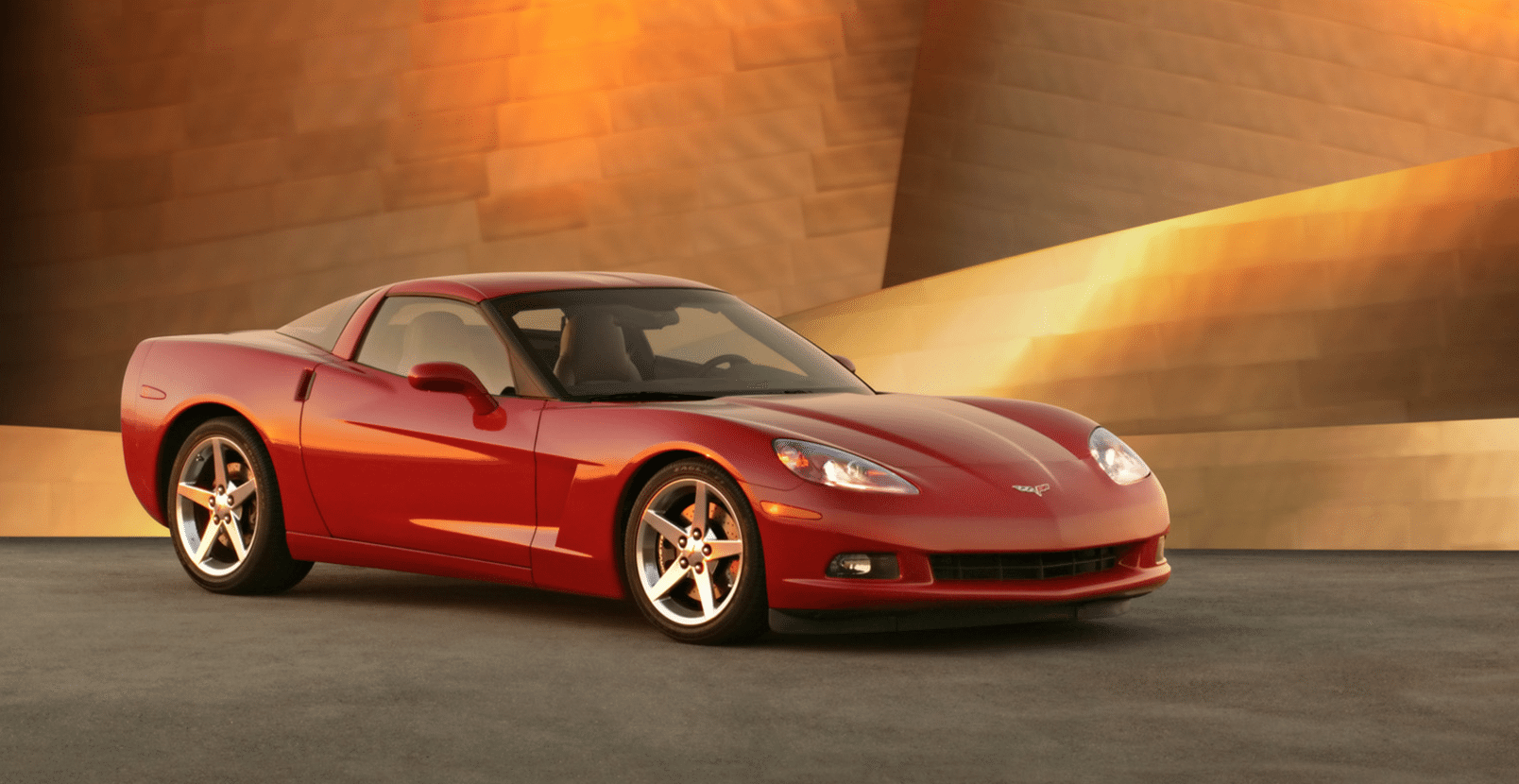
Naturally, the dimensional changes to the car would bring styling updates to the C6 as well. While the C5 had been a significant improvement over the C4’s design, Peters intention was to ensure that the C6 would evolve the design even further. Ironically, many of the design changes found on the 2005 Corvette actually evolved from design cues that Peters had taken from the 1963–1967 C2 Corvette Stingray. “I am not an aficionado of retro design,” Peters explained, “but I analyzed Corvettes over the years, focusing primarily on that ’63-67 vintage. What were the elements that made that car powerful and strong statement back then? You (had) those peaked fender shapes. You’ve got the way that upper sits on the body, like a jet fighter canopy cockpit.” Ironically, another series of elements that Peters drew on was actually that of military aircraft, especially the YF-22 jet fighter. “Designers always look to aircraft,” Peters said, “they’re usually singular in purpose. The function does not affect the aesthetic. They do what they look like they can do. They’re very directional.”
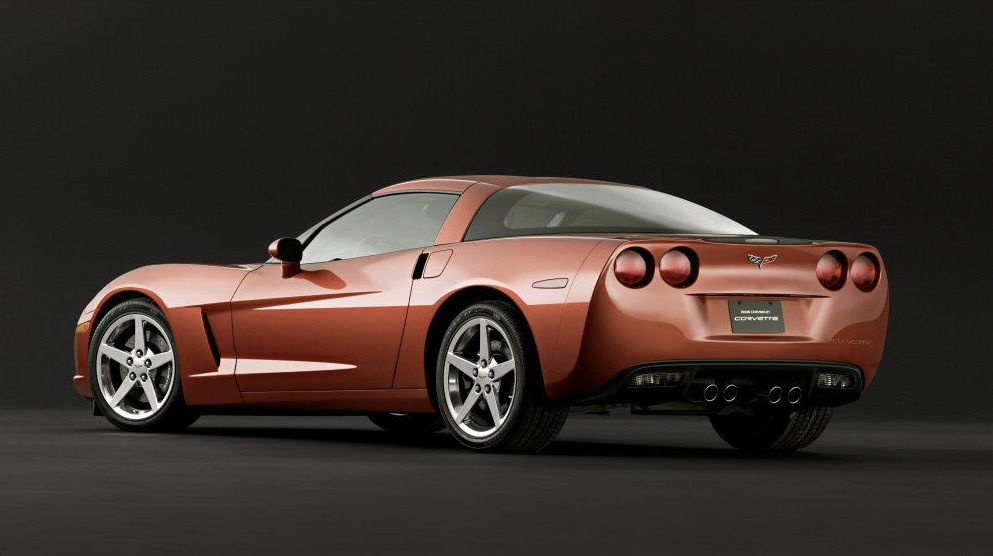
While many of the design cues of the C6 resonate from the previous generation, the exterior of the 2005 Corvette features a number of refinements that also makes it feel almost completely new.
The bodyside “coves”, a signature of Corvette since 1956, received an entirely new treatment that minimized the curvature of the previous design with a new look that used a deft blend of creases and curves to give them a more direct and streamlined appearance. The “double bubble” design of the coupe’s lift-off roof panel was also re-imagined, resulting in a roofline that was slightly more pronounced.
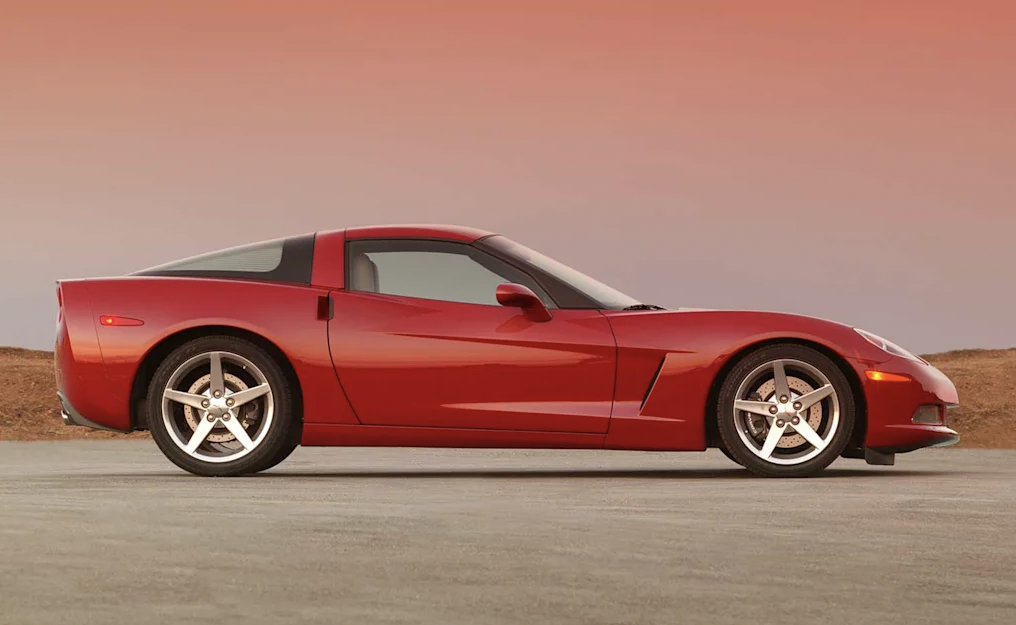
Perhaps the most notable modification to the upper section (the area above the door/fender line) from that of the C5 was the increased taper in the C6’s rear glass window. Following the line back, the C6 also featured a much more pointed, better defined rear end. The rear decks gain a “boat tail” character line swept neatly back form the belt (which is a throwback to the split-window Sting Ray coupe.)
The taillights in the rear of the car were made almost perfectly round again, and were mounted into a rear fascia that appeared less massive and lighter than the C5 Corvette’s had.
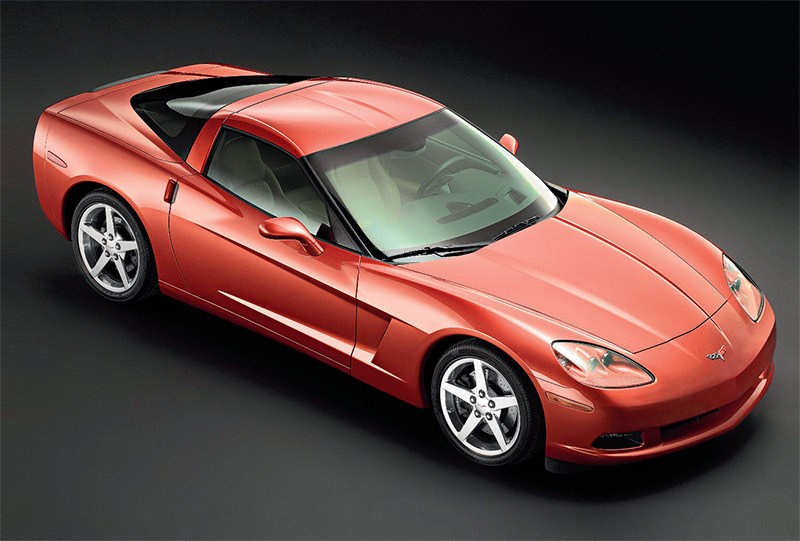
However, the most dramatic changes to the C6’s exterior was the decision that had been made to eliminate the pop-up headlights and return the Corvette to its first exposed-beam headlight design since 1962.
While the primary reason for the design change was a reduction in drag, the fixed lamps also helped to reduce the vehicle’s overall weight, lower the cost and complexity during the build process, and they helped give the C6 a new look that made it unique from its predecessor.
While the end result may have proven to be aesthetically pleasing, the decision was made only after it was decided that such a change would be a technical improvement in the design.
DID YOU KNOW: The 2005 Corvette was not initially offered with a solid, bright red exterior. Instead, the Bowling Green Corvette Assembly Plant built a single Torch Red Corvette, (a color carryover from the 2004 C5 Corvette) to demonstrate its viability. The first red that was offered to consumers was a somewhat darker “Precision Red” (Paint Code 27 (same as the 2004 Torch Red Option)). Later in the production year, “Precision Red” was replaced with a brighter “Victory Red” (Paint Code 74). As for the single “Torch Red” Corvette? It was acquired, and later sold, by the National Corvette Museum in Bowling Green, Kentucky.
Overall, the C6 measures 5.1 inches shorter and an inch narrower than the C5, but is 1.2 inches longer with a wheelbase that measures 106 inches overall. The wheelbase dimension was dictated by packaging requirements for the Cadillac XLR (see the C6 Corvette Overview for details), but it added to the Corvette’s purposeful new “wheels at the corners” stance.
The one downside to the reduction in the C6 Corvette’s size was that the interior now featured slightly less cargo space. Where the outgoing C5 Coupe had offered 24.8 cubic feet of cargo space, the 2005 C6 now offered just 22 cubic feet. Even tighter were the C6 Convertible with just 10.5 cubic feet of storage as compared to the 13.9 cubic feet found in the C5 Convertible.
If the exterior of the Corvette had been considered an improvement in the car’s outward appearance, then the all-new C6 interior was nothing short of a re-imagining and total advancement of the earlier design. The all-new cockpit was created by Peters and lead interior designer Eric Clough. While the C5’s interior had been criticized as being “too plasticky” or as containing “too much black”, the intent for the C6 was to improve upon those items while also simplifying the design.
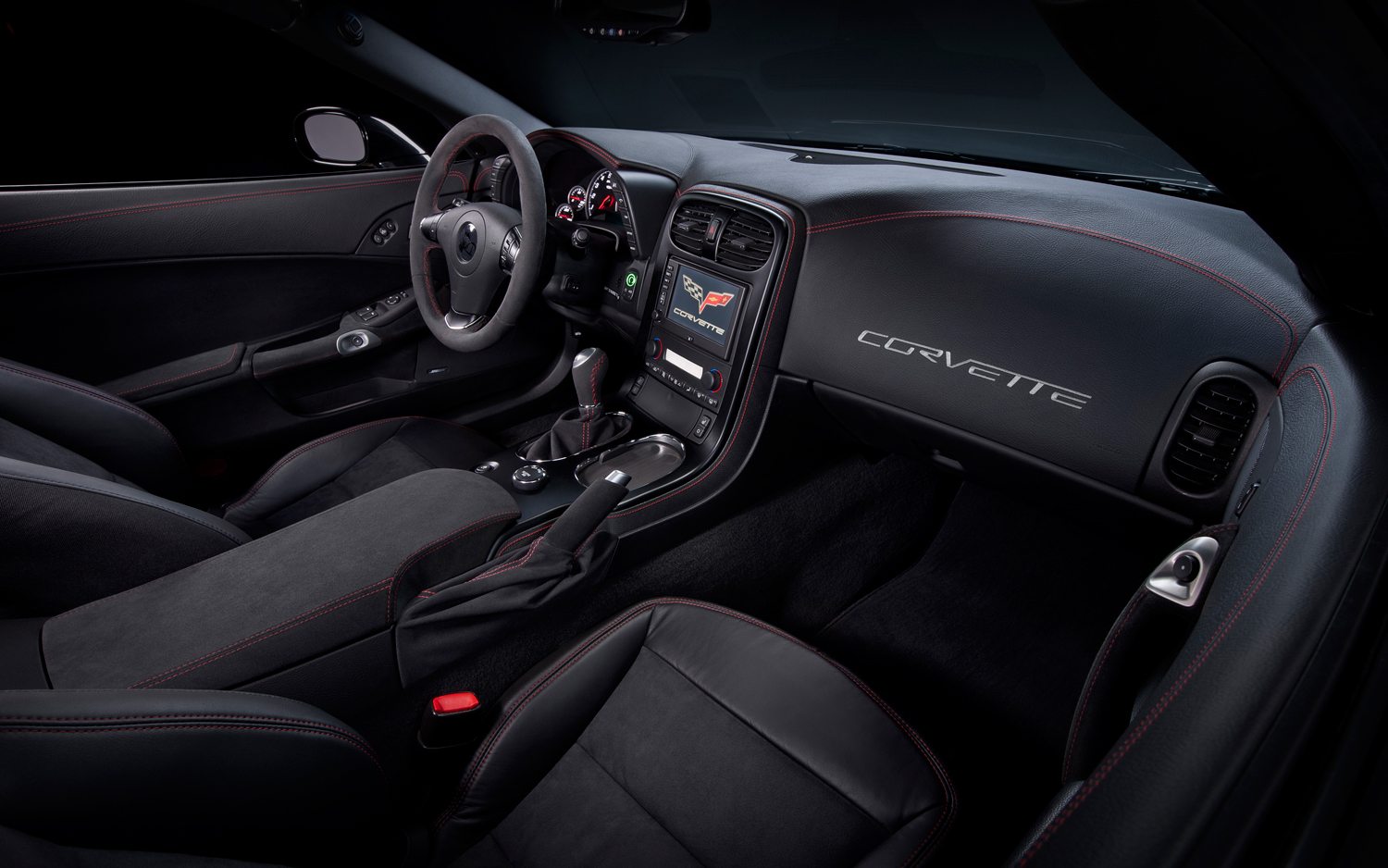
The most obvious design change was the dashboard. While it was laid out like the C5’s, it now featured a “twin cowl” theme that gave way to a clean, vertical, passenger side panel with a newly hidden airbag door. The seats were completely new – they featured longer cushions and more prominent side bolsters. The dashboards, doors and other interior elements were given a “high tech” look that was created through the use of aluminum and faux-metal accents throughout the cabin. The actual gauges on the dashboard remained mostly the same, with only minor – though notable differences – including the new badging for the C6 Corvette located in the center of the speedometer.
The audio and climate panels were reworked and featured fewer buttons. Those buttons that remained received improved markings which provided user greater understanding of their function.
RACING: 2005 saw the introduction of the new C6.R Corvette Race Car. It also saw Corvette Racing sweep the 2005 American Le Mans series, winning the GT1 Manufacturers Championship, the Drivers Championship, the Team Championship, and the Pit Crew Championship, along with victories at the 24 Hours of Le Mans and the Petit Le Mans.
In addition to these changes, another notable change was the absence of an ignition cylinder – either on the dashboard or on the steering column. Instead, a large engine-start rocker switch took its place. In place of a key, Corvette engineers instead developed a pocket transmitter that communicated wirelessly with the car, indicating that the vehicle could operate only when the transmitter was in close proximity to the car itself. This refinement, like many of the technology advancements made to the C6 Corvette, was actually a carryover from the development of the Cadillac XLR.
The center console was also revised and now featured a pair of proper cupholders that could easily be concealed beneath a sliding cover. The center storage bin/armrest assembly was also enlarged for improved functionality and greater comfort.
The interior designers even found space for small – but useful – door map pockets on both the driver and passenger doors. The doors received electric latches and pushbutton door releases on the inside as well as an exterior press pad (in place of the door handle found on the C5) for access to the car from the outside.
In addition to the electric controls, designers also integrated a mechanical release in the event that the cars power failed as the result of a dead battery (or other similar condition.)
As significant as all of the dimensional and aesthetic changes made to the car were the weight-saving measures implemented to reduce the car’s overall weight. Where the C5 Coupe had weighed in at 3,246lbs, the new 2005 C6 Coupe weighed just 3,179lbs.
Similarly, the C5 Convertible, which had weighed in at 3,248lbs in 2004 was now some forty-nine pounds lighter at 3,199lbs for the C6 Convertible. While some of this weight reduction was the result of the changes made to the car outwardly, much of the weight savings also occurred internally – both beneath the hood and below the floorpans.
Arguably, some of the most radical changes took place under the hood of the car. The 5.7 liter LS1 engine was replaced with the LS2, a 6.0L, 364 cubic inch engine.
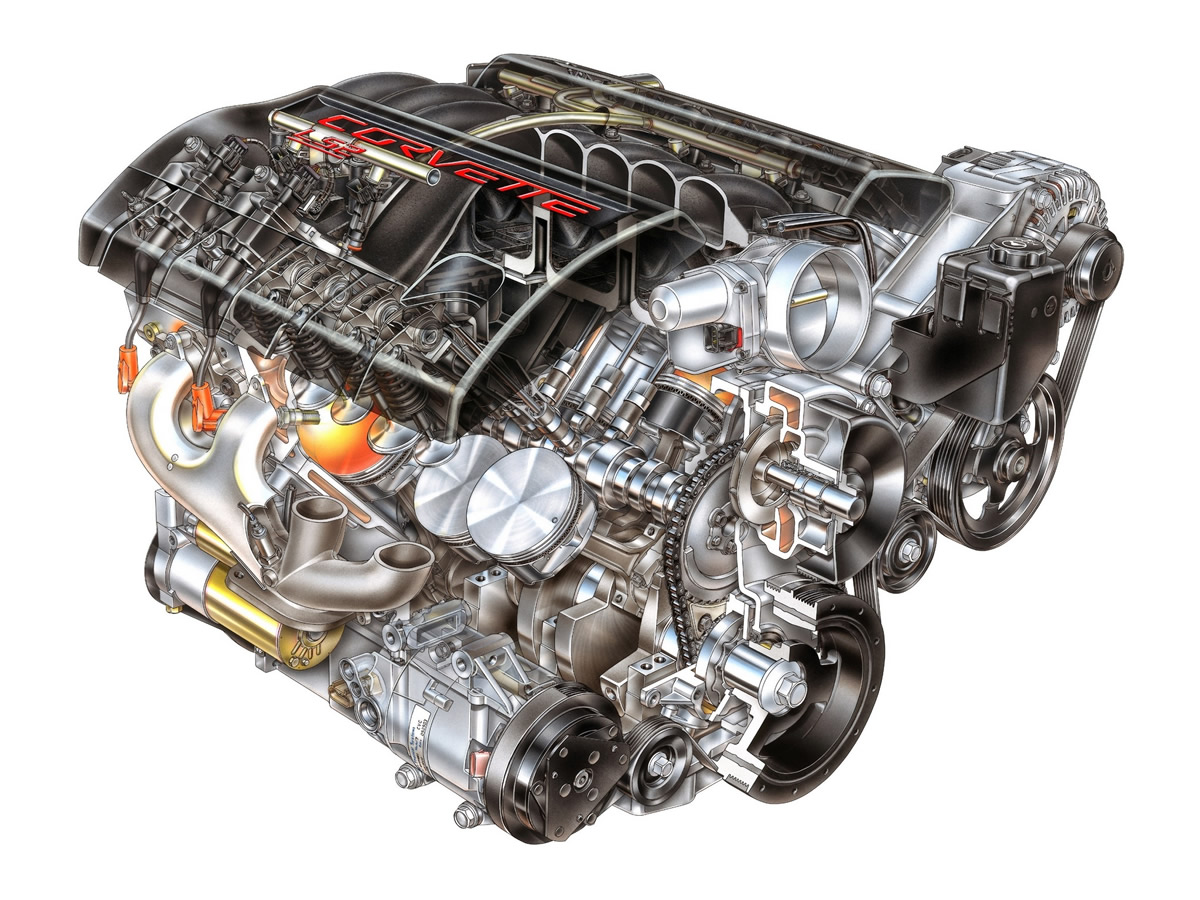
The larger displacement was achieved by increasing the engine bore to 4.00 inches/101.6 millimeters (as compared to 3.90 inches as found on the LS1) while no change occurred to the engine stroke, which remained at 3.62 inches.
In order to achieve the higher horsepower output, the LS2 engine featured a higher compression ratio (10.9:1), a higher-lift cam (with higher-rate valve springs), and a 15 to 20 percent improvement in the intake and exhaust flows.
The LS2 engine was lighter too, weighing some fifteen pounds less than the LS1, thanks in part to the installation of a smaller water pump, a specially designed aluminum oil pan (that took a quart less to fill but still ensured superior lubrication – even at during tight cornering), and thinner-walled exhaust manifolds. The exhaust system featured a light-weight, thin-wall manifold that resulted in 20 percent higher outflow, plus straight-through pipes and new mufflers that reduced back-pressure by 10 percent.
The new LS2, along with the changes to the bolt-on hardware and exhaust, improved standard horsepower from the LS1’s 350hp at 5,200 rpm to an impressive 400 horsepower at 6000 rpm. Torque also increased from 360/375 lb/ft at 4000 rpm to 400 lb/ft at 4,400 rpm. To gain a better appreciation for how much additional power the new 2005 C6 Corvette produced, it is important to note that the LS2 engine was only five horsepower less than the 2004 Z06’s LS6 engine. More impressive still is that it produced the same amount of torque at slightly lower engine rpm.
Mated to the LS2 engine was either a four-speed 4L65E Hydra-Matic automatic transmission or a Tremec T56 six-speed manual. The veteran four-speed automatic,which was actually an evolution of the C5’s 4L60-E automatic, was treated to Cadillac-style Performance Shift Algorithm programming. The Tremec T56 manual transmission received a revised linkage with more-positive action and an inch-shorter shifter.
In both cases, these transmissions were made available to consumers at no additional cost – a notable change over the C5 model, which had cost consumers extra when they chose to purchase a manual transmission. The wide-ratio T56 box used by the 2004 Z06 was also offered as an option on the new 2005 C6, but only when the Z51 performance package was ordered.
A large number of significant changes were made to the chassis. The all-independent suspension featured a setup that was reminiscent of that found on the C5, but featured entirely new components. The improvements included longer-stroke shock absorbers, which afforded the car increased wheel travel, stiffer anti-roll-bar mounts, and revised bushings. Spring and shock rates were recalibrated, and front caster angle was increased one degree for more-stable tracking. Magnetic Selective Ride Control, which was already a feature on the C5 Corvette, was revised to offer two different firmness modes (instead of three as found on the earlier model.)
New for the 2005 Corvette were 18-inch front, and 19-inch rear wheels. In addition to being taller than the previous generation, these tires were also wider, measuring 8.5 inches on the front rubber and 10 inches on the rear. To meet the rigors and drivability factors associated with owning a Corvette, each 2005 model was fitted with Goodyear Eagle F1 GS Extended Mobility tires.
These tires were mated to unique, newly designed factory rims measuring P285/40ZR-18 up front and P285/25ZR-19 in the rear of the car. To stop all of this steel and rubber, larger brakes were also included in the 2005 model year. The C6 Corvette now featured bigger, better brakes all-around, with front rotors measuring 12.8 inches across in the front and 12 inches even in the rear.
According to Chevrolet officials, a Z51-equipped C6 could nearly match a 2004 Z06’s lap time on the test track, which many considered a good thing since the Z06 package was not offered on the 2005 C6 Corvette. Included in the package were asymmetric-tread Eagle F1 Supercar tires in the same EEE sizes – P245/40ZR-18 (front), and P285/35ZR-19 (rear). In addition to the tires, the Z51 package included upgraded springs, shocks and anti-roll bars. The brakes were also more stout, with 13.4/13.0-inch cross-drilled rotors with high-performance brake pads.
The C5‘s “Uniframe”, which had proven itself to be rigid and lightweight, was carried over for the C6 model, though the new frame received extruded-aluminum reinforcements that were bolted and bonded to the door-hinge pillars. Additionally, an under-dash hydro-formed brace was also added. Its purpose was firmly tie the door-hinge pillars to the center chassis tunnel.
The added rigidity to the frame also proved beneficial for the convertible “ragtop” models, which returned for the 2005 model year. In addition to the frame reinforcements that had been introduced on the coupe, the convertible model also received additional rigidity via a new fiberglass tub that formed both the car’s trunk and the rear cockpit wall. This tub “bulkhead” not only reduced noise and body shake but helped to protect the trunk contents.
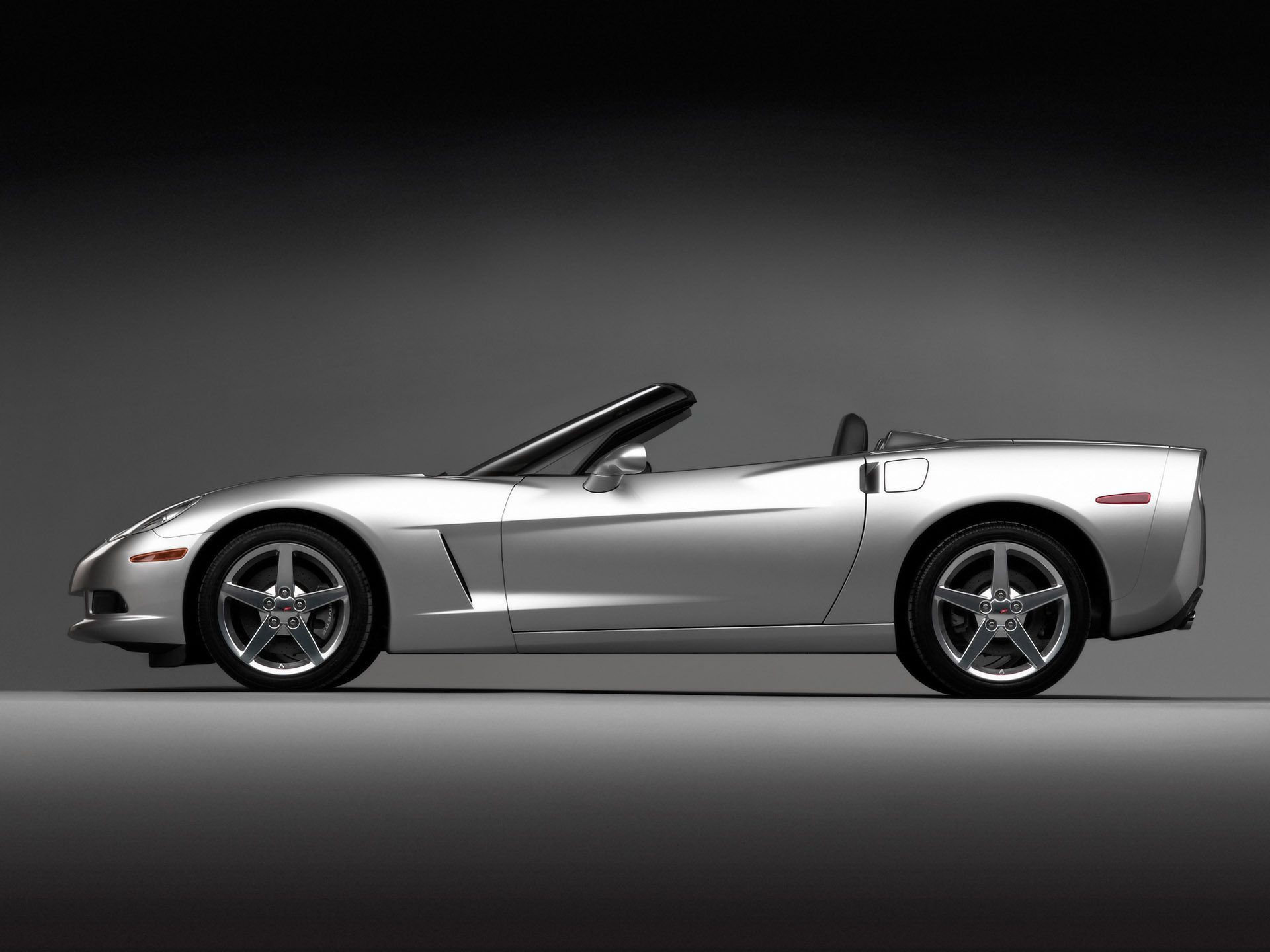
In addition to being more structurally sound that its C5 predecessor, the C6 convertible top was also more user friendly. For the first time since 1962, the Corvette was again available with an optional power top. The new mechanical convertible top required no more trunk space than the manual roof, weighed just 15 pounds, and moved fully up or down in less than 20 seconds. Whether ordered with the power (optional) or manual (standard) convertible option, the C6 top was shaped to generate less wind noise, and it was fully lined for additional insulation and sound dampening. When opening the driver or passenger door of the 2005 C6 convertible, the power window drops just slightly, allowing for better clearance. After the door is closed, the window firmly snugs up against the convertible top for a firm seal.
For both the coupe and convertible models (including Corvettes equipped with the Z51 option), a number of other first-time options were presented to consumers looking to purchase a 2005 Corvette including General Motors useful OnStar system and an optional XM satellite radio. Torso side airbags were offered as standard equipment on convertibles but was only available on coupes as part of the 1SA Preferred Equipment Package that also included perforated leather upholstery, a six-way power passenger seat, and a cargo net and cover. An upgraded 1SB Preferred Equipment Package group added heated seats, a seat memory system, power telescopic steering-wheel adjustment, Bose audio with a six-dish, in-dash CD player, an auto-dimming rearview mirror, and a new, three-way heads-up display.
Given all of the improvements made to the 2005 C6 Corvette, consumers and critics alike expected a sizable price increase over previous models. Instead, the 2005 coupe’s initial base price was $43,710, which was actually $125 less than the final 2004 C5 Coupe’s base price. The 2005 Corvette convertible was somewhat more expensive, with a starting price of $51,445, but even this was only $600 more than the the 2004 convertible model.
Overall, critics were very pleased with the look, feel and finish of the new Corvette. It made Car and Driver’s annual “10 Best” list and it beat out the redesigned 2005 Porsche 911 by one point in a Car and Driver’s comparison test. Additionally, the C6 took first place in a 2005 Road and Track comparison of nine sports-cars including the Honda S2000, the Dodge Viper, the Porsche 911, the Porsche Boxster, and the Nissan 350Z, amongst others. As quoted from the article, written by Sam Mitani on February 16, 2005, the C6 had “no real weaknesses and many strengths. It possess world class performance, a high level of comfort and dashing good looks. And it’s available for nearly half the price of a Porsche Carrera S.”
Consumer Guide listed the C6 Corvette as the perennial “Best Buy” among sporty/performance cars. As was stated by CG, “Corvette delivers thrilling acceleration, handling and braking…and costs tens of thousands less than rivals with similar performance. If you like your sports cars bold and brawny, there’s no better high-performance value and no stronger Best Buy in its class.”
The C6 Corvette produced impressive performance numbers from the very start. Although test results varied slightly, Chevy’s official report put the 2005 Corvette Coupe’s 0-60 time at just 4.2 seconds, a number that was validated by tests performed by companies like Car and Driver along with several others. The 2005 Convertible was somewhat slower off the line with a 0-60 time of 4.8 seconds, as reported by Road & Track magazine. Given that the 2005 convertible was a mere 20 pounds heavier than the coupe, this disparity between the two times left many critics questioning the officially reported time. Still, that time remains the measure to this day.
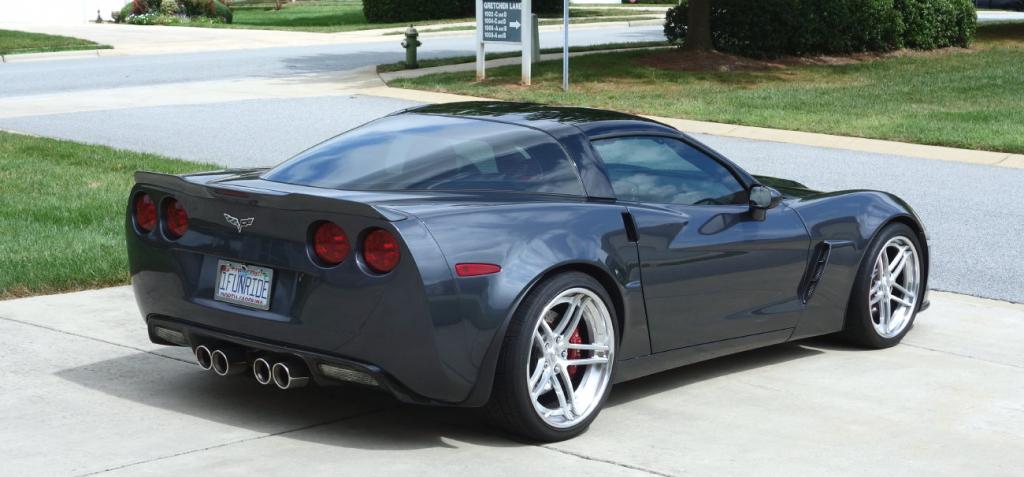
Regardless, the 2005 C6 Corvette was designed with far more than fast acceleration times in mind. The GM engineers assigned to the C6 had approached the project with the notion that they were going to build an all-out sports car. They succeeded. In addition to tremendous acceleration and top end power, the C6 was also praised for its strong stopping power and its “race-car” cornering capabilities. Moreover, the C6 Corvette did not beat up its occupants like the C4 and some of the earlier C5‘s had. Even the Z51 setup was more refined, providing drivers with a smooth, civilized ride on most roads.
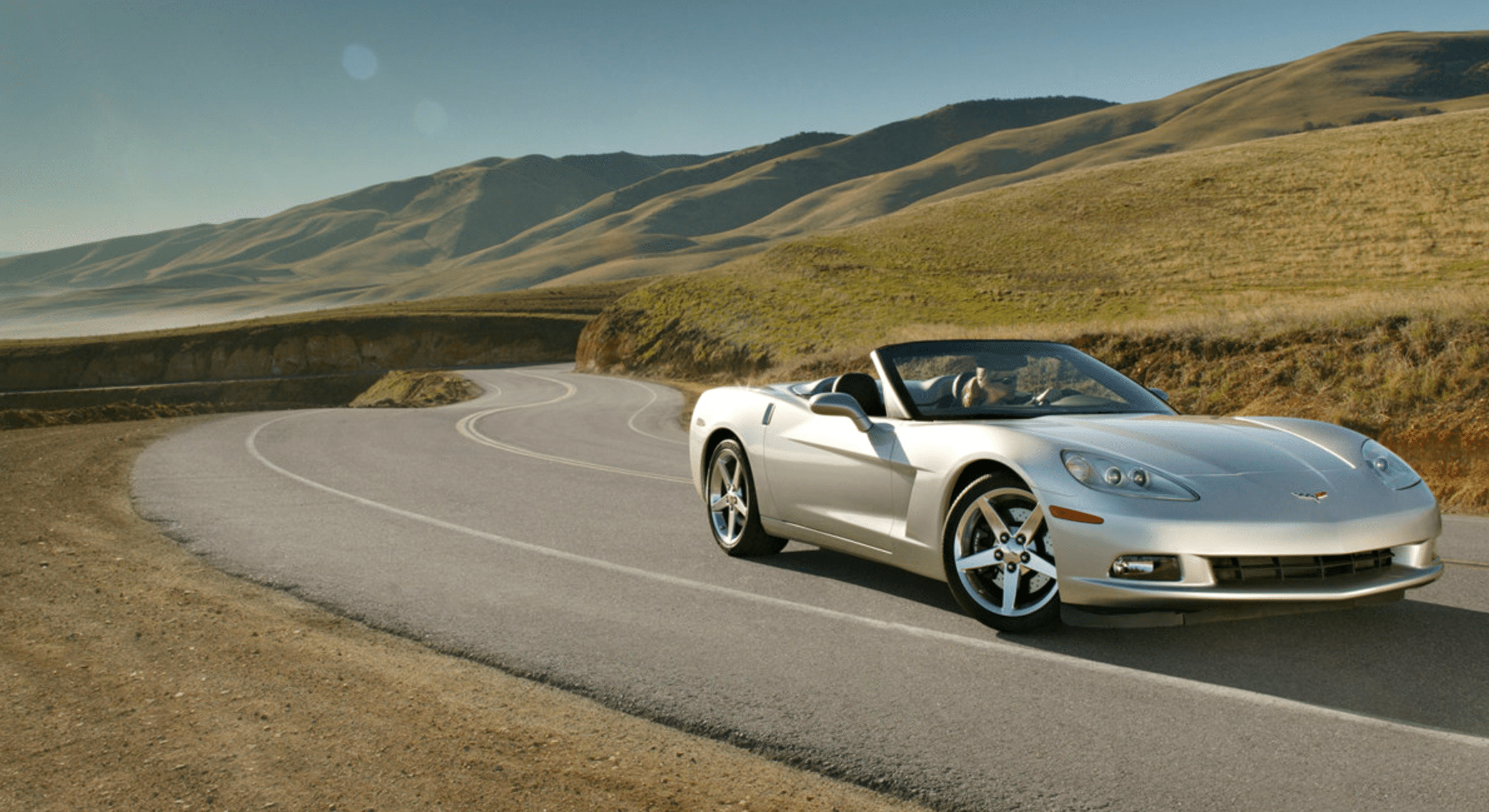
Production Volumes
Despite all of its improvements – and in spite of the price, which scarcely changed from the 2004 model – sales of the new 2005 Corvette were, perhaps, not quite as earth-shattering as GM had hoped. A total of 37,372 Corvettes were sold in 2005, which included 26,728 coupes and a mere 10,644 convertibles (for a full breakdown, check out our 2005 production volumes post). Still, the executives at Chevrolet noted the increase in overall sales, and began planning for the long-term future of the C6. It would become a future laced with some of the most powerful/highest performing Corvettes.
2005 Corvette Specifications & Performance
See the complete breakdown of technical specifications for the 2005 Corvette, including engine, suspension, brakes, body dimensions, and power. Read more: 2005 Corvette Specifications.
Engine & Transmission
The engine evolved, with displacement up by 18 cu in. to 364 cu. in. (6.0 liters) via a bore increase. Other engine changes, besides the designation update to LS2, included a compression ratio of 10.9:1 (was 10.1:1), more cam lift, better breathing on both the intake and exhaust and a redline (right) of 6,500 RPM – 500 RPM more than last years’ C5 LS1. Output was 400 horsepower and 400 lb.-ft. of torque – both nice, evenly matched round numbers achieved without subjecting buyers to a gas guzzler tax.
The shifting characteristics were improved on the Tremec T-56 six speed manual transmission. The throws on the shifter are shorter (6.56″ / 166.68 mm.) and had an excellent direct feel to them. The clutch effort is reasonable, especially for a high horsepower engine. The skip shift economy mode, a “tradition” dating back to the first C4 manual tranny was part of the C6 six speed. When driven moderately, shifting out of first caused fourth to be selected rather than second. Aggressive driving resulted in normal gear selection. The EPA ratings were MPG 18 mpg city, 28 mpg highway and 21 mpg combined.
Performance
The 2005 Corvette was a leap forward in terms of performance versus the prior year. The 0-60 mph time of 4.2 seconds was up there with European competition and a quarter mile of 12.5 seconds was no joke. That was quicker than a Porsche 911 Carrera or Jaguar XK8 and comparable to a Ferrari 360 Modena. There’s lots of torque at all engine speeds and the 400hp headline number made the C6 Corvette a standout performance wise. Read more: 2005 Corvette Specs and Performance.
2005 Corvette Vehicle Identification Numbers (VIN)
The last six digits begin at 100001 and run through 137341. The pilot and prototype cars were given a VIN number in this VIN series. Each Vehicle Identification Number (VIN) is unique to an individual car. Ending VIN Does Not Match Total Quantity Because 2005 Production Included 32 Prototype Builds. For all 2005 Corvettes, the Vehicle Identification Number (VIN) was stamped on a plate on the inner vertical surface of the left windshield pillar visible through the windshield. More 2005 Corvette VIN information here.
2005 Corvette Price & Options
Core Features & Factory Options
The C6 was more evolutionary than revolutionary. The suspension was mostly the same, with some tweaking that resulted in better on-center steering feel. Chassis specs were similar, with C5 advances like the transverse leaf springs, balsa wood floor construction and hydroformed side rails also part of the C6.
The famous Z51 suspension was packaged differently starting with the 2005 C6. In 2004 it was known as the “Performance Handling Package” (RPO Z51; $395.00) but in 2005 was promoted to “Performance Package” (RPO Z51; $1,495.00). Along with different springs, shocks and anti-sway bars, it included larger cross drilled brake rotors (right), power steering and transmission fluid coolers, special gear ratios and Goodyear Eagle F1 SC Extended Mobility Asymmetric Tread tires. This would be the option to get if race track duty was your intention; think of it as a 2005 Corvette Z06. The F55 Magnetic Selective Ride Control was not available with the Z51.
Interior updates addressed complaints that the C5 cockpit was too dark (“Looks like a cave” commented one observer) and monotone which resulted in an induced case of claustrophobia. The interior was lightened up some and real aluminum accents were added to the inside door opener button (below, middle) and the shifter (below right). The result was more user friendly controls and a more open feeling, even though the passenger area was the same volume. The four spoke steering wheel was for 2005 only; 2006 and later C6 Corvettes got three spoke steering wheels. Electronics took a giant leap in the C6 as a DVD based navigation system, OnStar and XM satellite radio became available as factory installed options.
The engine start button. Keys as they usually function were eliminated in the 2005 Corvette. A Keyless Access system required only that one had possession of the access transmitter to open a locked door and start the car. The doors were opened from the outside by pressing a switch located behind the door handle or from the inside by pressing another button on the inside door panel. A small conventional key was included for glovebox and center console entry as well as emergency access. A similar system was used in the Cadillac XLR. A Corvette first: heated seats were available as an option.
Colors
There were a total of ten colors for the 2007 model year Corvette. The colorss and breakdowns in terms of production were the following: Arctic White 1,968 (5.27%), LeMans Blue 3,759 (10.06%), Precision Red 1,304 (3.49%), Black 7,995 (21.39%), Velocity Yellow 760 (2.03%), Machine Silver 6,865 (18.37%), Daytona Sunset Orange 2,981 (7.98%), Victory Red 5,617 (15.03%), Millennium Yellow 2,002 (5.36%), Monterey Red 717 (1.92%), Magnetic Red 3,404 (9.11%). For the first time in a long time, Red wasn’t the most popular color, with Black making up 21% of total production in the top spot. More 2005 color information here.
Pricing & Options
The Base Corvette Coupe with 346 cu. in. 400 hp engine and six speed manual transmission started at $44,245, while the Base Corvette Convertible with 346 cu. in. 400 hp engine and six speed manual transmission started at $52,245. The two core packages available for 2005 were the Coupe Equipment Group and the Convertible Equipment Group. More information on the details here.
| CODE | DESCRIPTION | QUANTITY | PRICE |
| 1YY07 | Base Corvette Coupe | 26,728 | $44,245 |
| 1YY67 | Bass Corvette Convertible | 10,644 | $52,245 |
| 1SA | Preferred Equipment Group – Coupe | 3,763 | $1,405 |
| 1SB | Preferred Equipment Group – Coupe | 22,319 | $4,360 |
| 1SB | Preferred Equipment Group – Convertible | 10,306 | $2,955 |
| C2L | Dual Removable Roof Panels (Coupe) | 2,585 | $1,400 |
| CC3 | Removable Roof Panel, transparent (Coupe) | 8,469 | $750 |
| CM7 | Power Convertible Top | 7,541 | $1,995 |
| F55 | Magnetic Selective Ride Control | 9,041 | $1,695 |
| G90 | Performance 3.15 Axle (w/Auto Trans.) | 15,112 | $395 |
| MX0 | Four-speed Automatic Transmission | 22,380 | $0 |
| QG7 | Polished Aluminum Wheels | 27,080 | $1,295 |
| QX1 | Competition Gray Alum. Wheels (Late) | 621 | $295 |
| R8C | Corvette Museum Delivery | 831 | $490 |
| UE1 | OnStar System | 19,634 | $695 |
| U2K | XM Satellite Radio | 21,896 | $325 |
| U3U | AM/FM CD w/DVD Nav, BOSE | 4,676 | $1,400 |
| Z51 | Performance Package | 15,345 | $1,495 |
| 19U | LeMans Blue exterior paint | 3,759 | $300 |
| 45U | Velocity Yellow exterior paint | 760 | $750 |
| 79U | Millennium Yellow exterior paint | 2,002 | $750 |
| 80U | Monterey Red exterior paint (late) | 717 | $750 |
| 86U | Magnetic Red exterior paint | 3,404 | $750 |
Read more: 2005 Corvette pricing and factory options.
2005 Corvette Gallery
Tom Peters, the C6 stylist, stepped back to the past on a few areas of the C6 design. The C6 hood has some things in common with the C3 hood, including the power bulge, the high-acreage look and the pointed nose. The styling was a contemporary look that also included a number of cues from the past so the traditional Corvette fans would feel at home. See full 2005 C6 Corvette Image Gallery
2005 Corvette Videos
Below are some original reviews we found of the 2005 Corvette. We have lots more 2005 Corvette videos here.


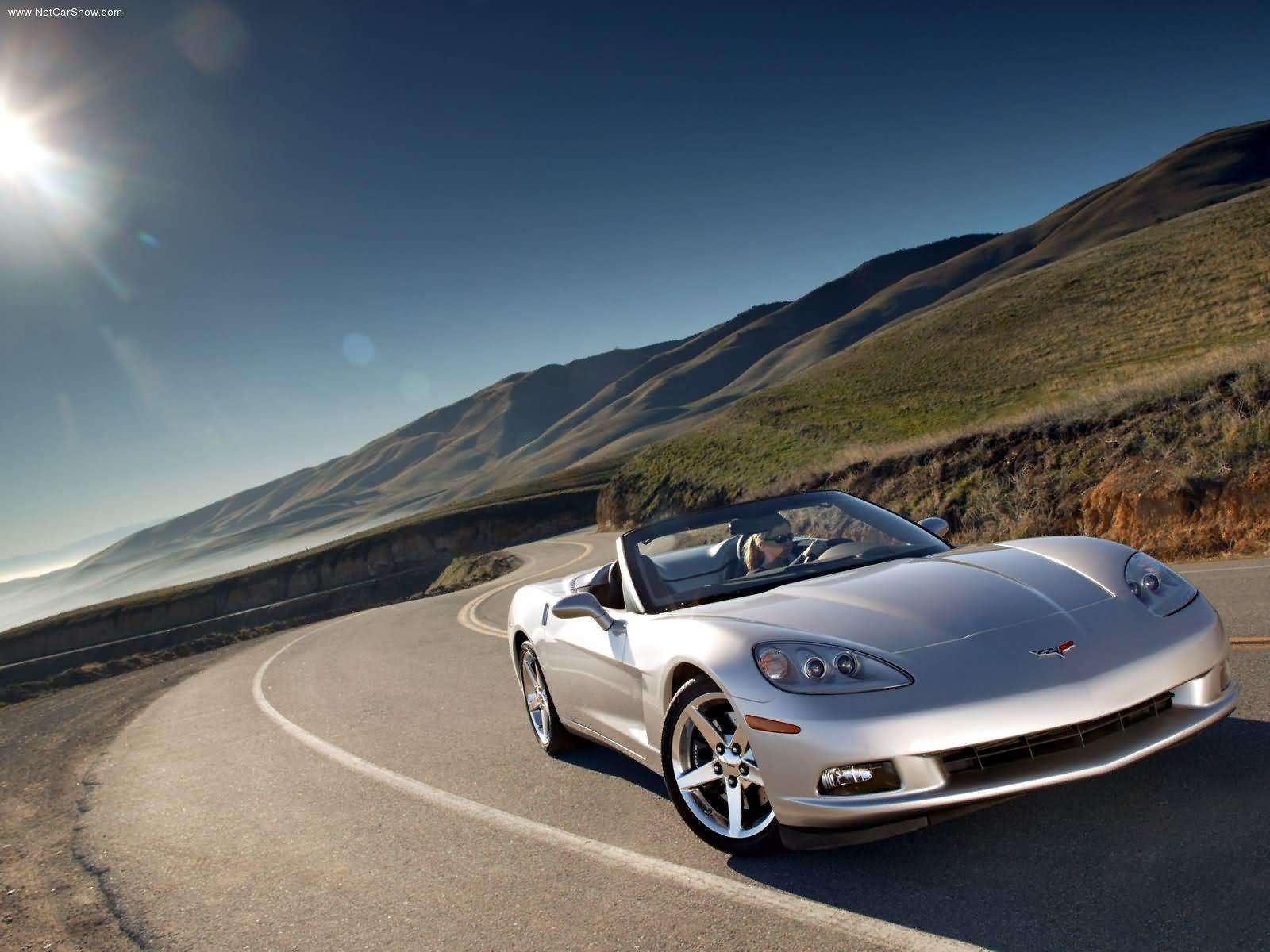
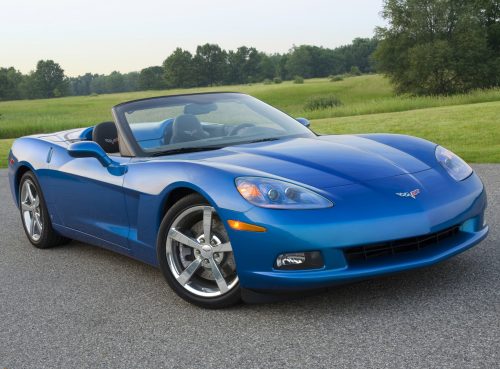
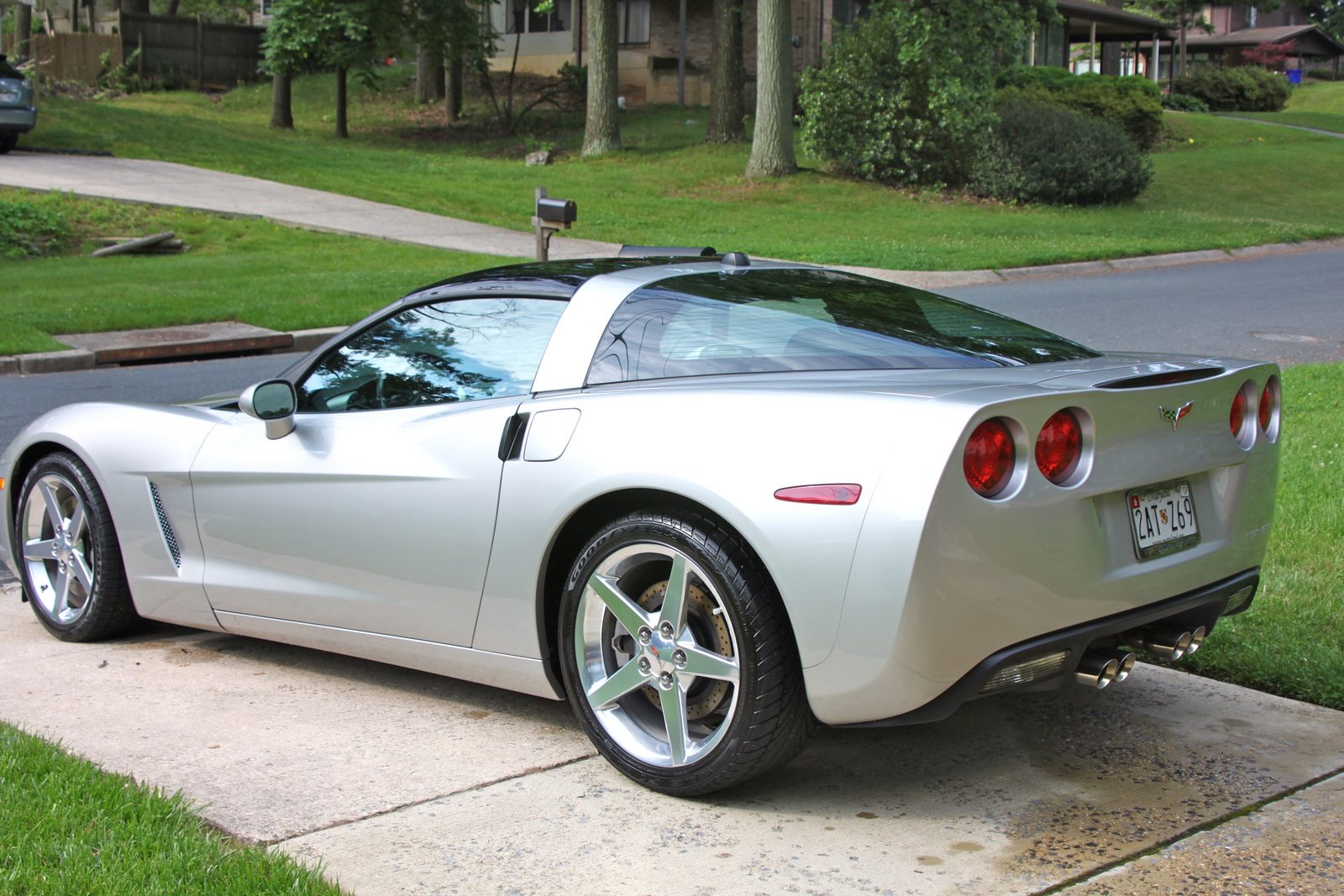

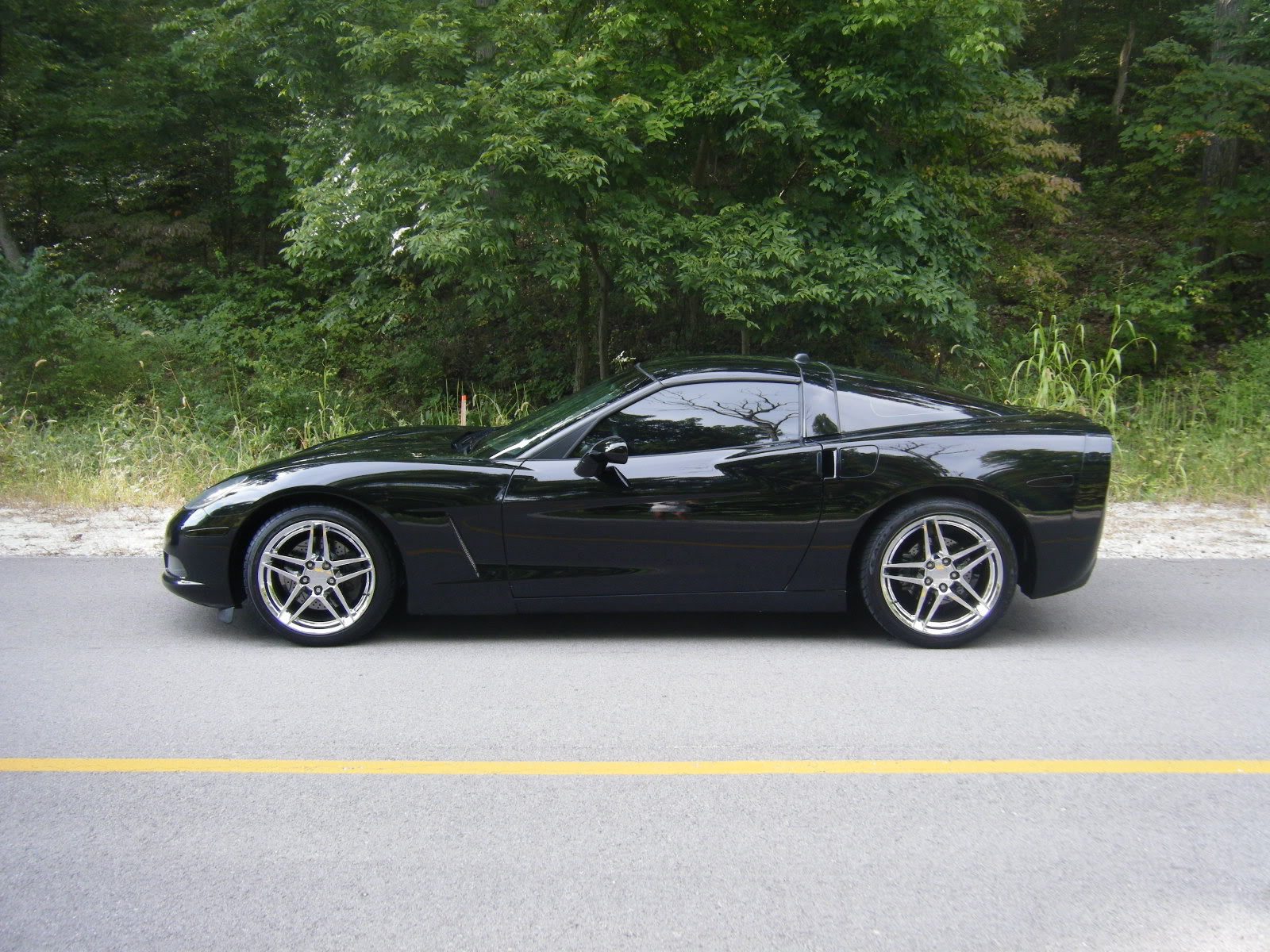
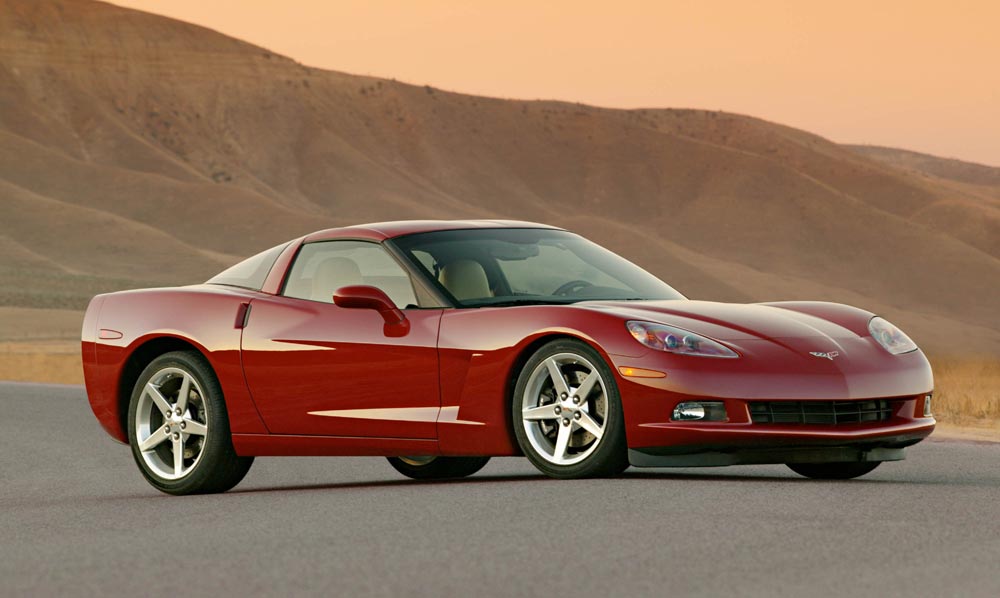
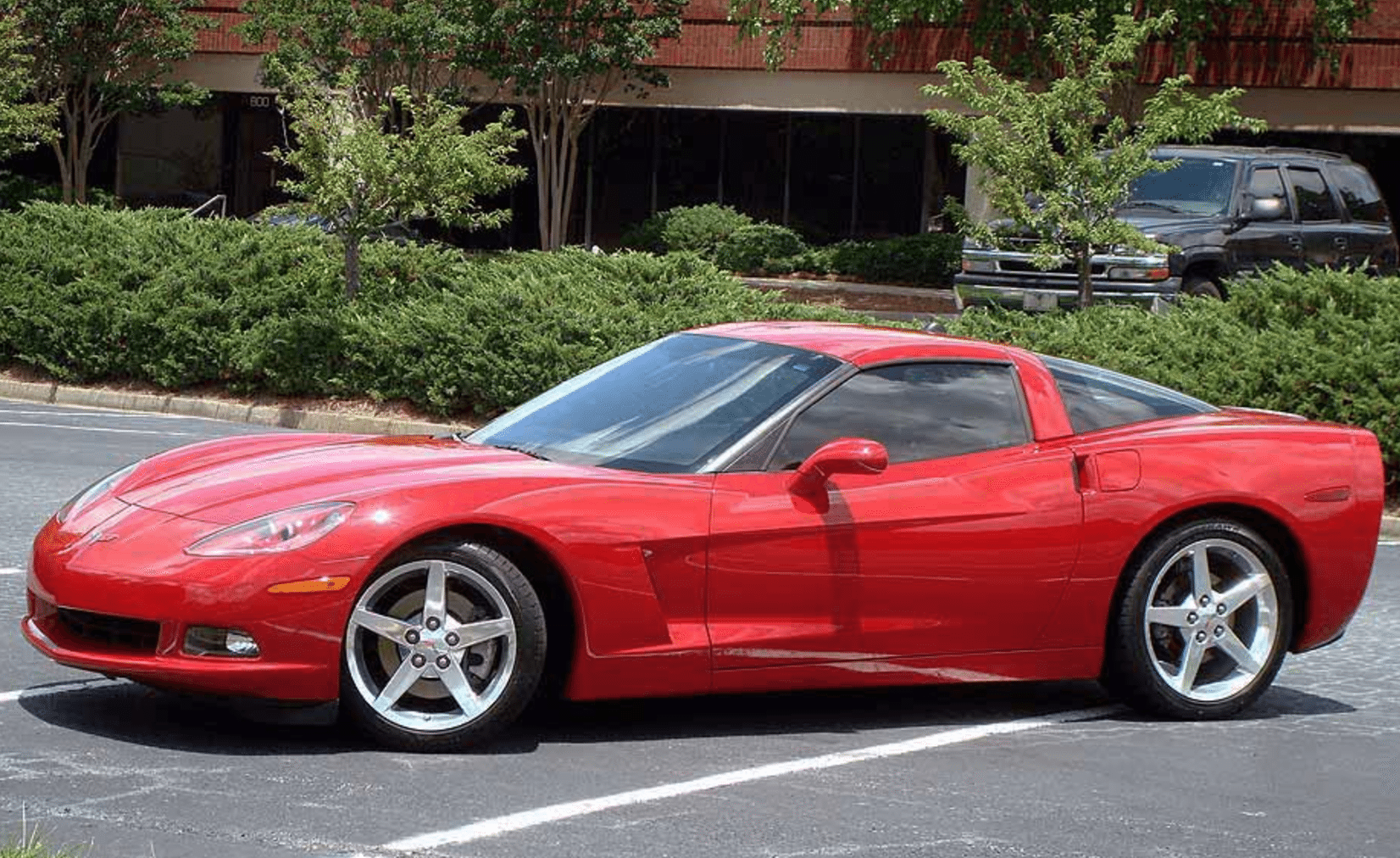
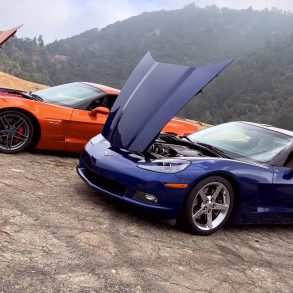
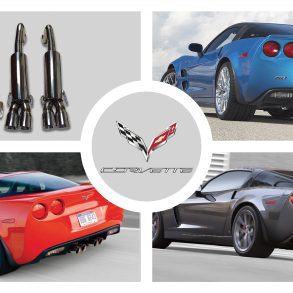

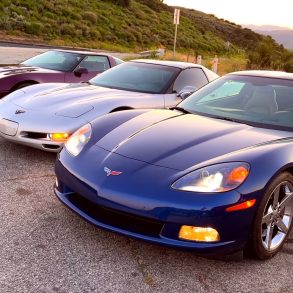
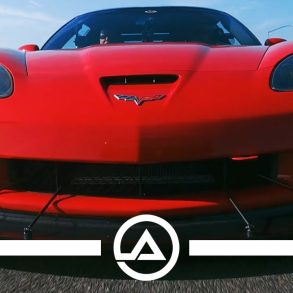
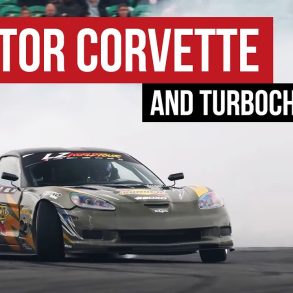



looking for options list ? i have 2005 convert
Go to corvette museum web site and you can order both window sticker and build sheet
How can I obtain a copy of my Corvettes original window sticker???????
2005 Corvette Exterior & Interior Colors
Color Options & Quantities
86 Monterey Red 2,981
About 1/4 way down the page, you list “Monterey” twice, the 86 paint code is Magnetic Red, not Monterey Red.
Thanks for all the great info!
Please explain how 347 in.³ equals 6 L